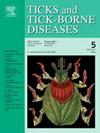Reevaluating the presence of Rhipicephalus australis (Acari: Ixodidae) in Southeast Asia: A phylogenetic approach based on Cambodian tick samples
IF 3.4
2区 医学
Q2 INFECTIOUS DISEASES
引用次数: 0
Abstract
Morphological variability between Rhipicephalus australis and R. microplus has led to taxonomic ambiguity, leading to species misidentification. Rhipicephalus australis is reported to have a distribution range in Pacific Ocean region extending to several Southeast Asian countries, including Cambodia, although its presence in continental Southeast Asia has not been supported by molecular data. With growing evidence of conflicting morphological characters, this study aimed to evaluate the presence of R. australis in Cambodia using both morphological and molecular identification. Tick specimens were collected from cattle across 21 provinces of Cambodia, and a subset of 95 R. microplus complex (37 morphologically identified as R. australis, 39 R. microplus, and 19 nymphs) was selected for molecular analysis. DNA barcoding of the cox1 gene was performed, and a maximum likelihood phylogenetic tree revealed that all specimens clustered within R. microplus clade A. These findings, along with previous observations from other regions, suggest that, in the absence of molecular data, there is no definitive evidence to support the presence of R. australis in continental Southeast Asia, particularly in Cambodia.
东南亚南棘头蜱(蜱螨:伊蚊科)存在的再评估:基于柬埔寨蜱类样本的系统发育方法
南头猪与小头猪形态差异导致分类歧义,导致物种误认。据报道,南头鼻虫在太平洋地区的分布范围延伸到包括柬埔寨在内的几个东南亚国家,尽管其在东南亚大陆的存在尚未得到分子数据的支持。由于越来越多的证据表明,形态特征相互矛盾,本研究旨在通过形态和分子鉴定来评估柬埔寨南裂叶蝉的存在。从柬埔寨21个省的牛身上采集蜱虫标本,选取95个小蜱虫复合体(37个经形态鉴定为南方蜱虫,39个为小蜱虫,19个为雌雄蜱虫)进行分子分析。cox1基因的DNA条码技术进行,最大似然系统发育树显示所有标本集群内r . microplus进化枝a。这些研究结果,从其他地区,连同以前的观测表明,在缺乏分子数据,没有明确的证据支持在东南亚大陆r .南极光的存在,尤其是在柬埔寨。
本文章由计算机程序翻译,如有差异,请以英文原文为准。
求助全文
约1分钟内获得全文
求助全文
来源期刊

Ticks and Tick-borne Diseases
INFECTIOUS DISEASES-MICROBIOLOGY
CiteScore
6.90
自引率
12.50%
发文量
185
审稿时长
6-12 weeks
期刊介绍:
Ticks and Tick-borne Diseases is an international, peer-reviewed scientific journal. It publishes original research papers, short communications, state-of-the-art mini-reviews, letters to the editor, clinical-case studies, announcements of pertinent international meetings, and editorials.
The journal covers a broad spectrum and brings together various disciplines, for example, zoology, microbiology, molecular biology, genetics, mathematical modelling, veterinary and human medicine. Multidisciplinary approaches and the use of conventional and novel methods/methodologies (in the field and in the laboratory) are crucial for deeper understanding of the natural processes and human behaviour/activities that result in human or animal diseases and in economic effects of ticks and tick-borne pathogens. Such understanding is essential for management of tick populations and tick-borne diseases in an effective and environmentally acceptable manner.
 求助内容:
求助内容: 应助结果提醒方式:
应助结果提醒方式:


